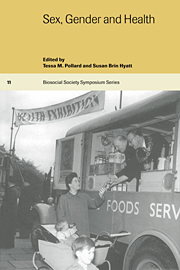Book contents
- Frontmatter
- Contents
- List of contributors
- Preface
- 1 Sex, gender and health: integrating biological and social perspectives
- 2 Parental manipulation of postnatal survival and well-being: are parental sex preferences adaptive?
- 3 Gender bias in South Asia: effects on child growth and nutritional status
- 4 Sex, gender and cardiovascular disease
- 5 Social meanings and sexual bodies: gender, sexuality and barriers to women's health care
- 6 Poverty and the medicalisation of motherhood
- 7 The vanishing woman: gender and population health
- 8 Agency, opposition and resistance: a systemic approach to psychological illness in sub-dominant groups
- Glossary
- Index
3 - Gender bias in South Asia: effects on child growth and nutritional status
Published online by Cambridge University Press: 07 December 2009
- Frontmatter
- Contents
- List of contributors
- Preface
- 1 Sex, gender and health: integrating biological and social perspectives
- 2 Parental manipulation of postnatal survival and well-being: are parental sex preferences adaptive?
- 3 Gender bias in South Asia: effects on child growth and nutritional status
- 4 Sex, gender and cardiovascular disease
- 5 Social meanings and sexual bodies: gender, sexuality and barriers to women's health care
- 6 Poverty and the medicalisation of motherhood
- 7 The vanishing woman: gender and population health
- 8 Agency, opposition and resistance: a systemic approach to psychological illness in sub-dominant groups
- Glossary
- Index
Summary
Introduction: biological differences in male and female child mortality
There is a consistent phenomenon in human reproduction whereby more males are born than females. The sex ratio at birth is approximately 106 in almost all populations, that is, 106 males are born for every 100 females (Coale 1991). This excess of male births is counterbalanced by higher mortality rates among males at all stages of postnatal life.
The differential mortality of males and females has been attributed to an inherent biological vulnerability of the male sex. One explanation for excess male mortality is the possession of only one X chromosome. In addition to having only single copies of normal genes, males have a greater risk of expressing X-linked recessive disorders than females. In fact, the contribution of X-linked disorders to male infant mortality is thought to be small (Waldron 1983), but the general effect of having only one X chromosome is less well understood. Another explanation for sex differences in mortality is the immaturity of males relative to females at all stages of development. By four months of gestation, skeletal development is three weeks more advanced in the female foetus compared with the male and, at birth, girls are 4–6 weeks more mature than boys. Girls appear to be more mature physiologically in several organ systems and this is thought to contribute to their greater survival at birth (Tanner 1989). For example, males have much greater rates of respiratory distress syndrome in the neonatal period, which in turn arises from the immaturity of the male lungs (Waldron 1983).
- Type
- Chapter
- Information
- Sex, Gender and Health , pp. 37 - 52Publisher: Cambridge University PressPrint publication year: 1999
- 7
- Cited by



